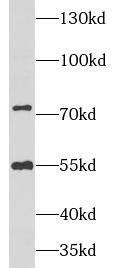Products
NRG1 antibody
| Synonyms: | Pro-neuregulin-1 antibody, membrane-bound isoform (Pro-NRG1)|Neuregulin-1 Alternative names: Acetylcholine receptor-inducing activity (ARIA)|Breast cancer cell differentiation factor p45|Glial growth factor|Heregulin (HRG)|Neu differentiation factor|Sensory and motor neuron-derived factor|NRG1|GGF|HGL|HRGA|NDF|SMDF antibody | ||
| Catalogue No.: | FNab05856 | Reactivity: | Human, Mouse |
| Host: | Rabbit | Tested Application: | ELISA, WB, IHC, IF, IP |
| Clonality: | polyclonal | Isotype: | IgG |
| Size | Price |
|---|---|
| 100µg | Inquiry |
- SPECIFICATIONS
- CITATIONS
- FIGURES
- CONDITIONS
- FAQS
- Product Name
- NRG1 antibody
- Catalogue No.
- FNab05856
- Size
- 100μg
- Form
- liquid
- Purification
- Immunogen affinity purified
- Purity
- ≥95% as determined by SDS-PAGE
- Clonality
- polyclonal
- Isotype
- IgG
- Storage
- PBS with 0.02% sodium azide and 50% glycerol pH 7.3, -20℃ for 12 months(Avoid repeated freeze / thaw cycles.)
- Immunogen
- neuregulin 1
- Alternative Names
- Pro-neuregulin-1 antibody, membrane-bound isoform (Pro-NRG1)|Neuregulin-1 Alternative names: Acetylcholine receptor-inducing activity (ARIA)|Breast cancer cell differentiation factor p45|Glial growth factor|Heregulin (HRG)|Neu differentiation factor|Sensory and motor neuron-derived factor|NRG1|GGF|HGL|HRGA|NDF|SMDF antibody
- UniProt ID
- Q02297
- Observed MW
- 55 kDa and 72 kDa
- Tested Applications
- ELISA, WB, IHC, IF, IP
- Recommended dilution
- WB: 1:500-1:1000; IHC: 1:50-1:200 IP:1:500-1:2000; IF: 1:50-1:500
 human liver tissue were subjected to SDS PAGE followed by western blot with FNab05856(NRG1 antibody) at dilution of 1:250
human liver tissue were subjected to SDS PAGE followed by western blot with FNab05856(NRG1 antibody) at dilution of 1:250
 IP Result of anti-NRG1 (IP:FNab05856, 4ug; Detection:FNab05856 1:1000) with mouse liver tissue lysate 4000ug.
IP Result of anti-NRG1 (IP:FNab05856, 4ug; Detection:FNab05856 1:1000) with mouse liver tissue lysate 4000ug.
 Immunohistochemistry of paraffin-embedded human breast cancer using FNab05856(NRG1 antibody) at dilution of 1:100
Immunohistochemistry of paraffin-embedded human breast cancer using FNab05856(NRG1 antibody) at dilution of 1:100
 Immunofluorescent analysis of HepG2 cells using FNab05856 (NRG1 antibody) at dilution of 1:25 and Alexa Fluor 488-conjugated Goat Anti-Rabbit IgG(H+L)
Immunofluorescent analysis of HepG2 cells using FNab05856 (NRG1 antibody) at dilution of 1:25 and Alexa Fluor 488-conjugated Goat Anti-Rabbit IgG(H+L)
- Background
- Direct ligand for ERBB3 and ERBB4 tyrosine kinase receptors. Concomitantly recruits ERBB1 and ERBB2 coreceptors, resulting in ligand-stimulated tyrosine phosphorylation and activation of the ERBB receptors. The multiple isoforms perform diverse functions such as inducing growth and differentiation of epithelial, glial, neuronal, and skeletal muscle cells; inducing expression of acetylcholine receptor in synaptic vesicles during the formation of the neuromuscular junction; stimulating lobuloalveolar budding and milk production in the mammary gland and inducing differentiation of mammary tumor cells; stimulating Schwann cell proliferation; implication in the development of the myocardium such as trabeculation of the developing heart. Isoform 10 may play a role in motor and sensory neuron development. Binds to ERBB4(PubMed:10867024, PubMed:7902537). Binds to ERBB3(PubMed:20682778). Acts as a ligand for integrins and binds(via EGF domain) to integrins ITGAV:ITGB3 or ITGA6:ITGB4. Its binding to integrins and subsequent ternary complex formation with integrins and ERRB3 are essential for NRG1-ERBB signaling. Induces the phosphorylation and activation of MAPK3/ERK1, MAPK1/ERK2 and AKT1(PubMed:20682778). Ligand-dependent ERBB4 endocytosis is essential for the NRG1-mediated activation of these kinases in neurons(By similarity).
- Journal:
- Molecular Biology Reports
- Author:
- Dr. B R Ambedkar Centre for Biomedical Research, University of Delhi, Delhi, 110007, India.
- Cited Date:
- 2025-06-13
- Product:
How many times can antibodies be recycled?
First, usually it's not suggested to recycle antibodies. After use, buffer system of antibodies has changed. The storage condition of recycled antibodies for different customers also varies. Thus, the performance efficiency of recycled antibodies can’t be guaranteed. Besides, FineTest ever conducted the antibody recycling assay. Assay results show recycling times of different antibodies also varies. Usually, higher antibody titer allows more repeated use. Customers can determine based on experimental requirements.
Notes: After incubation, we recycle rest antibodies to centrifuge tube and store at 4℃. High titer antibodies can be stored for a minimum of one week. Reuse about three times.
What are components of FineTest antibody buffer?
Components of FineTest antibody buffer are usually PBS with proclin300 or sodium azide, BSA, 50% glycerol. Common preservative is proclin300 or sodium azide, which is widely applied in the lab and industry.
How about the storage temperature and duration of FineTest antibodies?
Most antibodies are stored at -20℃. Directly-labeled flow cytometry antibodies should be stored at 2 - 8℃. The shelf life is one year. If after sales issues for purchased antibodies appear, return or replacement is available. Usually, antibodies can be still used after the one-year warranty. We can offer technical support services.
Is dilution required for FineTest antibodies? What’s the dilute solution?
Directly-labeled flow cytometry antibodies are ready-to-use without dilution. Other antibodies are usually concentrated. Follow the dilution ratio suggested in the manual. Dilute solution for different experiments also varies. Common antibody dilution buffers are acceptable(e.g. PBST, TBST, antibody blocking buffer).
How to retrieve antibodies for immunohistochemistry?
Common retrieval buffers: Tris-EDTA Buffer(pH 9.0); Citrate Buffer(pH 6.0)
Heat induced antibody retrieval:
Method 1: Water-bath heating: Put the beaker with retrieval buffer and slide in the boiling water bath. Keep the boiling state for 15min. Naturally cool to room temperature;
Method 2: Microwave retrieval: Put the beaker with retrieval buffer and slide in the microwave oven. Heat at high power for 5min, Switch OFF for 3min, Heat at medium power for 5min. Naturally cool to room temperature.
How to choose secondary antibodies?
(1) Secondary antibodies react with primary antibodies. Thus, secondary antibodies should be against host species of primary antibodies. E.g. If the primary antibody is derived from rabbit, the relevant secondary antibody should be against rabbit. E.g. goat anti rabbit or donkey anti rabbit.
(2) Choose secondary antibody conjugates according to the experimental type, e.g. ELISA, WB, IHC etc. Common enzyme conjugated secondary antibodies are labelled by HRP, AP etc. Fluorescin or dye labelled secondary antibodies are applied in immunofluorescence and flow cytometry(e.g. FITC, Cy3).
